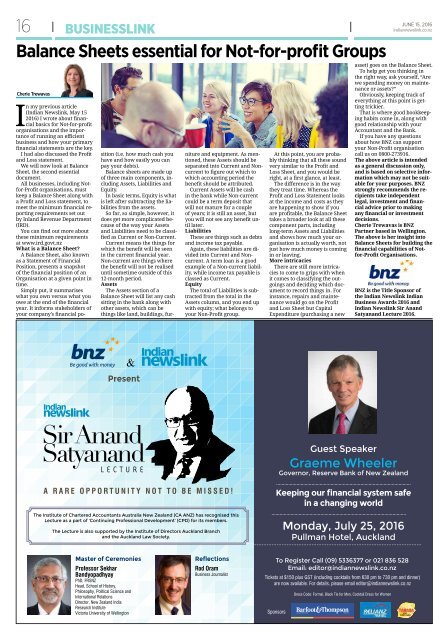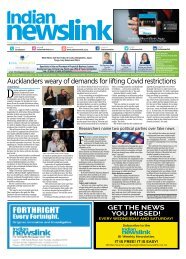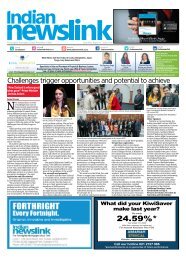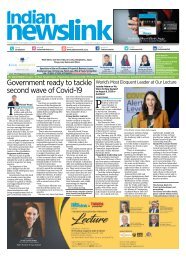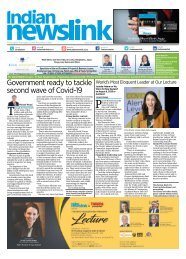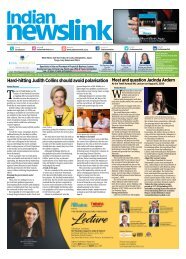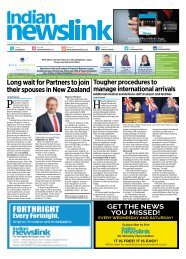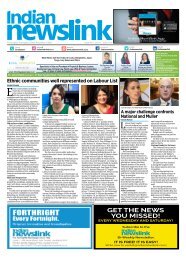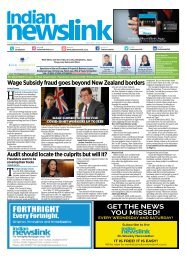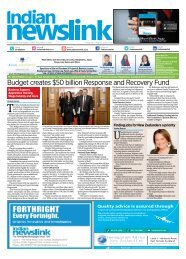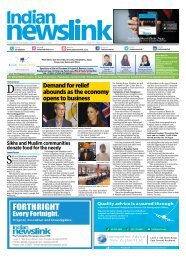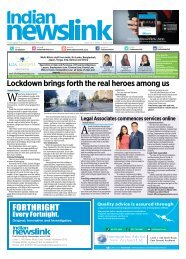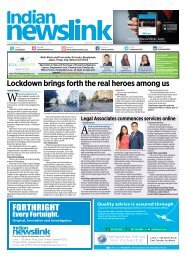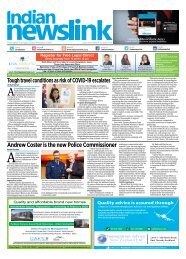Create successful ePaper yourself
Turn your PDF publications into a flip-book with our unique Google optimized e-Paper software.
16<br />
JUNE 15, <strong>2016</strong><br />
BUSINESSLINK<br />
Balance Sheets essential for Not-for-profit Groups<br />
Cherie Trewavas<br />
In my previous article<br />
(<strong>Indian</strong> <strong>Newslink</strong>, May 15<br />
<strong>2016</strong>) I wrote about financial<br />
basics for Not-for-profit<br />
organisations and the importance<br />
of running an efficient<br />
business and how your primary<br />
financial statements are the key.<br />
I had also discussed the Profit<br />
and Loss statement.<br />
We will now look at Balance<br />
Sheet, the second essential<br />
document.<br />
All businesses, including Notfor-Profit<br />
organisations, must<br />
keep a Balance Sheet along with<br />
a Profit and Loss statement, to<br />
meet the minimum financial reporting<br />
requirements set out<br />
by Inland Revenue Department<br />
(IRD).<br />
You can find out more about<br />
these minimum requirements<br />
at www.ird.govt.nz<br />
What is a Balance Sheet?<br />
A Balance Sheet, also known<br />
as a Statement of Financial<br />
Position, presents a snapshot<br />
of the financial position of an<br />
Organisation at a given point in<br />
time.<br />
Simply put, it summarises<br />
what you own versus what you<br />
owe at the end of the financial<br />
year. It informs stakeholders of<br />
your company’s financial position<br />
(i.e. how much cash you<br />
have and how easily you can<br />
pay your debts).<br />
Balance sheets are made up<br />
of three main components, including<br />
Assets, Liabilities and<br />
Equity.<br />
In basic terms, Equity is what<br />
is left after subtracting the liabilities<br />
from the assets.<br />
So far, so simple, however, it<br />
does get more complicated because<br />
of the way your Assets<br />
and Liabilities need to be classified<br />
as Current or Non-Current.<br />
Current means the things for<br />
which the benefit will be seen<br />
in the current financial year.<br />
Non-current are things where<br />
the benefit will not be realised<br />
until sometime outside of this<br />
12-month period.<br />
Assets<br />
The Assets section of a<br />
Balance Sheet will list any cash<br />
sitting in the bank along with<br />
other assets, which can be<br />
things like land, buildings, furniture<br />
and equipment. As mentioned,<br />
these Assets should be<br />
separated into Current and Noncurrent<br />
to figure out which to<br />
which accounting period the<br />
benefit should be attributed.<br />
Current Assets will be cash<br />
in the bank while Non-current<br />
could be a term deposit that<br />
will not mature for a couple<br />
of years; it is still an asset, but<br />
you will not see any benefit until<br />
later.<br />
Liabilities<br />
These are things such as debts<br />
and income tax payable.<br />
Again, these liabilities are divided<br />
into Current and Noncurrent.<br />
A term loan is a good<br />
example of a Non-current liability,<br />
while income tax payable is<br />
classed as Current.<br />
Equity<br />
The total of Liabilities is subtracted<br />
from the total in the<br />
Assets column, and you end up<br />
with equity; what belongs to<br />
your Non-Profit group.<br />
At this point, you are probably<br />
thinking that all these sound<br />
very similar to the Profit and<br />
Loss Sheet, and you would be<br />
right, at a first glance, at least.<br />
The difference is in the way<br />
they treat time. Whereas the<br />
Profit and Loss Statement looks<br />
at the income and costs as they<br />
are happening to show if you<br />
are profitable, the Balance Sheet<br />
takes a broader look at all these<br />
component parts, including<br />
long-term Assets and Liabilities<br />
and shows how much your organisation<br />
is actually worth, not<br />
just how much money is coming<br />
in or leaving.<br />
More intricacies<br />
There are still more intricacies<br />
to come to grips with when<br />
it comes to classifying the outgoings<br />
and deciding which document<br />
to record things in. For<br />
instance, repairs and maintenance<br />
would go on the Profit<br />
and Loss Sheet but Capital<br />
Expenditure (purchasing a new<br />
asset) goes on the Balance Sheet.<br />
To help get you thinking in<br />
the right way, ask yourself, “Are<br />
we spending money on maintenance<br />
or assets?”<br />
Obviously, keeping track of<br />
everything at this point is getting<br />
trickier.<br />
That is where good bookkeeping<br />
habits come in, along with<br />
good relationship with your<br />
Accountant and the Bank.<br />
If you have any questions<br />
about how BNZ can support<br />
your Non-Profit organisation<br />
call us on 0800-273916.<br />
The above article is intended<br />
as a general discussion only,<br />
and is based on selective information<br />
which may not be suitable<br />
for your purposes. BNZ<br />
strongly recommends the recipients<br />
take independent<br />
legal, investment and financial<br />
advice prior to making<br />
any financial or investment<br />
decisions.<br />
Cherie Trewavas is BNZ<br />
Partner based in Wellington.<br />
The above is her insight into<br />
Balance Sheets for building the<br />
financial capabilities of Notfor-Profit<br />
Organisations.<br />
BNZ is the Title Sponsor of<br />
the <strong>Indian</strong> <strong>Newslink</strong> <strong>Indian</strong><br />
Business Awards <strong>2016</strong> and<br />
<strong>Indian</strong> <strong>Newslink</strong> Sir Anand<br />
Satyanand Lecture <strong>2016</strong>.<br />
&<br />
Present<br />
Guest Speaker<br />
Graeme Wheeler<br />
Governor, Reserve Bank of New Zealand<br />
A RARE OPPORTUNITY NOT TO BE MISSED!<br />
The Institute of Chartered Accountants Australia New Zealand (CA ANZ) has recognised this<br />
Lecture as a part of ‘Continuing Professional Development’ (CPD) for its members.<br />
The Lecture is also supported by the Institute of Directors Auckland Branch<br />
and the Auckland Law Society.<br />
Keeping our financial system safe<br />
in a changing world<br />
Monday, July 25, <strong>2016</strong><br />
Pullman Hotel, Auckland<br />
Master of Ceremonies<br />
Professor Sekhar<br />
Bandyopadhyay<br />
PhD, FRSNZ<br />
Head, School of History,<br />
Philosophy, Political Science and<br />
International Relations<br />
Director, New Zealand India<br />
Research Institute<br />
Victoria University of Wellington<br />
Reflections<br />
Rod Oram<br />
Business Journalist<br />
To Register Call (09) 5336377 or 021 836 528<br />
Email: editor@indiannewslink.co.nz<br />
Tickets at $150 plus GST (including cocktails from 630 pm to 730 pm and dinner)<br />
are now available. For details, please email editor@indiannewslink.co.nz<br />
Sponsors<br />
Dress Code: Formal, Black Tie for Men, Cocktail Dress for Women


